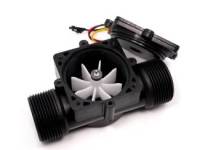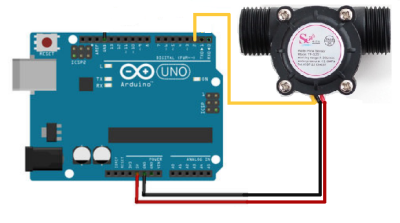Durchflussmessung
YF-S201
Der YF-S201 ist einer der am häufigsten verwendeten Hall-Effekt-Laufrad-Durchflussmesser.
Der Arduino-Durchflussmesser arbeitet nach dem Prinzip des Hall-Effekts. Dementsprechend induziert es eine Spannung im Falle einer Verschiebung eines Magnetfeldes senkrecht zum elektrischen Strom. Die Flüssigkeit trifft auf die Rotorrippen und dreht diese. Über der Rotorwelle befindet sich ein Hallsensor, der die Verschiebung des an der Rotorwelle angebrachten Magneten überwacht, sodass bei jeder Drehung ein Impuls erzeugt wird. Der Durchflussmesser empfängt im Allgemeinen etwa 4,5 Impulse pro Liter und pro Minute Flüssigkeitsstrom (dies hängt natürlich von der Größe des Sensors ab).
YF-S201 Sensor anschließen
Um eher kurze Impulse zu zählen, können Sie den Arduino-Interrupt-Port verwenden.
Eine Beschreibung hierzu finden Sie hier: interrupt Port.
Beispielprogramm
/* Liquid flow rate sensor -DIYhacking.com Arvind Sanjeev Measure the liquid/water flow rate using this code. Connect Vcc and Gnd of sensor to arduino, and the signal line to arduino digital pin 2. */ byte statusLed = 13; byte sensorInterrupt = 0; // 0 = digital pin 2 byte sensorPin = 2; // The hall-effect flow sensor outputs approximately 4.5 pulses per second per // litre/minute of flow. float calibrationFactor = 4.5; volatile byte pulseCount; float flowRate; unsigned int flowMilliLitres; unsigned long totalMilliLitres; unsigned long oldTime; void setup() { // Initialize a serial connection for reporting values to the host Serial.begin(9600); // Set up the status LED line as an output pinMode(statusLed, OUTPUT); digitalWrite(statusLed, HIGH); // We have an active-low LED attached pinMode(sensorPin, INPUT); digitalWrite(sensorPin, HIGH); pulseCount = 0; flowRate = 0.0; flowMilliLitres = 0; totalMilliLitres = 0; oldTime = 0; // The Hall-effect sensor is connected to pin 2 which uses interrupt 0. // Configured to trigger on a FALLING state change (transition from HIGH // state to LOW state) attachInterrupt(sensorInterrupt, pulseCounter, FALLING); } /** * Main program loop */ void loop() { if((millis() - oldTime) > 1000) // Only process counters once per second { // Disable the interrupt while calculating flow rate and sending the value to // the host detachInterrupt(sensorInterrupt); // Because this loop may not complete in exactly 1 second intervals we calculate // the number of milliseconds that have passed since the last execution and use // that to scale the output. We also apply the calibrationFactor to scale the output // based on the number of pulses per second per units of measure (litres/minute in // this case) coming from the sensor. flowRate = ((1000.0 / (millis() - oldTime)) * pulseCount) / calibrationFactor; // Note the time this processing pass was executed. Note that because we've // disabled interrupts the millis() function won't actually be incrementing right // at this point, but it will still return the value it was set to just before // interrupts went away. oldTime = millis(); // Divide the flow rate in litres/minute by 60 to determine how many litres have // passed through the sensor in this 1 second interval, then multiply by 1000 to // convert to millilitres. flowMilliLitres = (flowRate / 60) * 1000; // Add the millilitres passed in this second to the cumulative total totalMilliLitres += flowMilliLitres; unsigned int frac; // Print the flow rate for this second in litres / minute Serial.print("Flow rate: "); Serial.print(int(flowRate)); // Print the integer part of the variable Serial.print("L/min"); Serial.print("\t"); // Print tab space // Print the cumulative total of litres flowed since starting Serial.print("Output Liquid Quantity: "); Serial.print(totalMilliLitres); Serial.println("mL"); Serial.print("\t"); // Print tab space Serial.print(totalMilliLitres/1000); Serial.print("L"); // Reset the pulse counter so we can start incrementing again pulseCount = 0; // Enable the interrupt again now that we've finished sending output attachInterrupt(sensorInterrupt, pulseCounter, FALLING); } } /* Insterrupt Service Routine */ void pulseCounter() { // Increment the pulse counter pulseCount++; }



